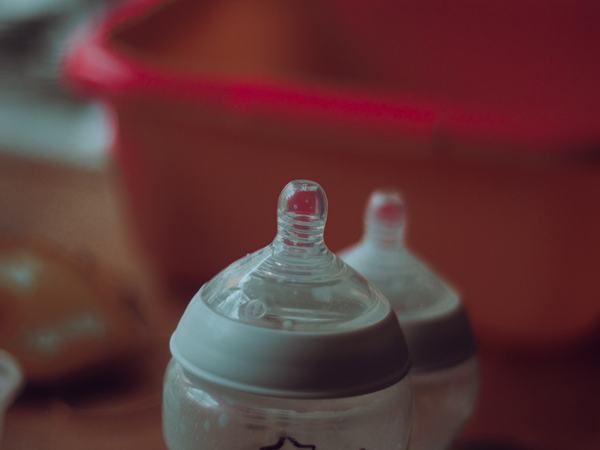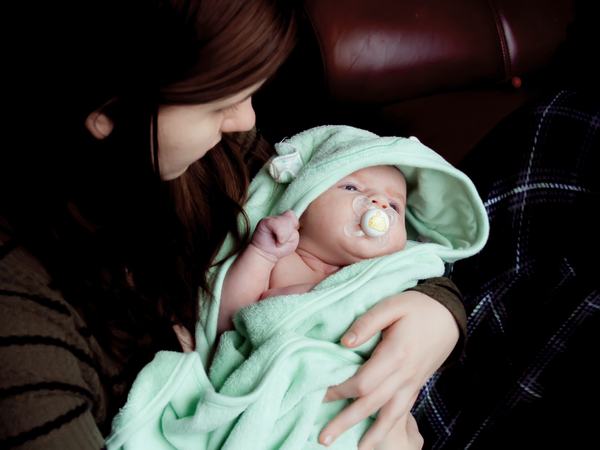What you should know about pacifiers
For many parents, the question arises after the birth, possibly even before the birth, as to when and whether a soother should be used at all.

In this article, you will find out what you need to know about soothers. It looks at possible times to introduce them, the benefits, possible risks and what you should look out for when choosing one.
But first of all: I don't think the term soother is appropriate, I prefer to use the term pacifier, because that's what it's all about. It should not be in the mouth all the time, but should really only be used for a limited time. But more on this later.
What are the advantages of a soother?
The advantage that most parents hope for from a soother is that it calms the child. The child can calm down and relax by sucking on the soother. This is particularly helpful if the child is unable to fall asleep or falls asleep.
Many babies who are introduced to the soother early accept it well. However, some babies reject it, which can have very different reasons. Sometimes it helps to change the manufacturer or model.
One advantage of the soother is that babies can satisfy their need to suck, which is quite great at the beginning, regardless of hunger. Some mothers feel relieved and freer because the baby is not sucking on the breast and can therefore be with other people when sucking on the soother.
Some mothers hope for relief if they have sore nipples or pain when breastfeeding, but this is not an advantage of a soother. This often only makes the problem worse. In this case, it makes more sense to look for possible causes and remedy them if possible. Your midwife or a lactation consultant can help you with this.
If your baby is exclusively bottle-fed, the soother can help your baby to satisfy its need to suck, which is independent of food intake.

There are also studies that show that using a soother could reduce the risk of sudden infant death syndrome. However, when I look at the study, it is hardly conclusive as many factors were not taken into account. So I wouldn't see this as an advantage.
What are the possible risks of a pacifier?
One risk that can occur is that the baby no longer sucks well at the breast or even refuses it due to sucking on a soother. This can lead to so-called sucking confusion.
This risk exists at any time in the breastfeeding relationship and does not depend on how often the soother is used. It can therefore also occur with only occasional use.
It is also possible that your baby will not take a soother or will only take a single model.
In addition, frequent soother use can lead to changes in the jaw and muscles, which can later lead to misaligned teeth or similar. I will therefore give you a few more tips on selection and use later on.
If your child uses a soother a lot, this may cause difficulties with speech development. This can affect both the amount of speech itself as well as pronunciation.
Continuous use, including at night, can also increase the risk of tooth decay. However, this is not only due to the soother, but also to the diet and care of the teeth.
When should you introduce a soother?
If you are considering offering your baby a soother, there are a few aspects to consider regarding the timing.
First and foremost, breastfeeding and milk production should be well established. You should not have any major breastfeeding problems and the amount of milk should already be well adapted to your baby's needs. This is usually the case after around six to eight weeks. I would only start using a soother before this in a few exceptional cases.

I would not start using a soother with your baby as long as there are clear breastfeeding difficulties, as this could make the situation even more difficult, as I have already described above.
Now you may not be breastfeeding or overfeeding and it is uncertain whether the feeding situation will change. It is possible that the situation with complementary feeding is just right. Even in this case, I would not offer a pacifier in the first few days. With the bottle or other feeding methods, the sucking pattern must also first be established.
What types of soothers are there and what should you look out for when buying one?
There are now many different pacifiers on the market. This applies to both the shape and the material.
Whether a soother is made of rubber or latex is not important in the first instance. What is more important in this context is that it is free of harmful chemicals, fragrances or similar.
In terms of shape, it makes sense to ensure that the shaft of the soother, i.e. the section between the baby's lips, is as low as possible. This is important insofar as the mouth closure should be ensured as far as possible. This also plays a role with regard to the position of the teeth.
The sucking part should be as small as possible so that it does not press the tongue down to the floor of the mouth. However, the tongue should still be able to move as far up towards the palate as possible, as is the case with the natural tongue resting position, where the tongue lies flat against the palate. The sucking part should therefore be as transversely oval as possible.
Changing to a larger pacifier with increasing age is neither necessary nor sensible. If a soother is used, the smallest size can always be used.
Overall, the soother should still be light and flexible. There should be no tension on the jaw. This is one of the reasons why pacifier chains are not a good idea.
There should be holes on the shield of the soother, which is on the outside of your baby's mouth, to allow air to circulate. This reduces the risk of skin irritation.
What should you bear in mind when using it?
A soother should always be used in a similar way to a medicine. This means that it makes sense to always ask yourself before use whether it is really necessary at that moment. The adage "As much as necessary, as little as possible" applies quite well here.

In this context, it becomes clear that overall use should be limited in time. It doesn't make sense for your baby to have the soother in their mouth all the time. You should always bear in mind the risks that I have described above.
I also recommend that you don't buy lots of soothers. Otherwise you will end up with a soother in every place and it will be used more often, even though you may not have wanted to at first. It makes more sense to have one or two soothers in one place.
When your baby or child has fallen asleep, I think it makes sense to take the soother out of the mouth and gently close the mouth. This supports nasal breathing and encourages the tongue to rest naturally.

If your child is playing or wants to talk about something, they don't need a pacifier at that moment. It can help to think about whether your baby would also suck on the breast in this situation. If not, the soother is probably not necessary either, as the breast is the model for the soother.
How can you wean your baby or child off a soother?
There are many different approaches and tips for weaning off the soother. I think it's important that the one you choose suits your situation and your child's character. I would therefore just like to give you a few suggestions here.
It can be a good way to gradually reduce the use of the soother. This could start in situations where the soother is already less necessary or where other strategies have already been found to calm the child. This is then extended further and further.
Another option is to leave the soother out completely. However, some children find this too much of a challenge.
Some parents also cut off the tip of the soother so that sucking is no longer effective.
Whichever route you choose, it is important that you accompany your child through the process. If the soother has been the main soother so far, it may take some time before other strategies are established. Feelings such as anger or sadness are completely normal in this context and should not be suppressed. They are allowed to be there and you can accompany your child through them.
Are there also soothers for adults?
Yes, there are also soothers for adults and teenagers. These are sometimes used for people with disabilities. However, as this is not my area of expertise and not the focus of this article, I will not go into this any further.
Conclusion
Using a soother can make everyday life with your baby or child easier. However, there are also some risks that you should be aware of. It therefore makes sense to consider beforehand whether you want to offer your baby a soother and if so, when and which one exactly.
I hope this article has helped you. Feel free to write to me in the comments about your thoughts and experiences with soothers. I look forward to reading about them!
No comments yet.